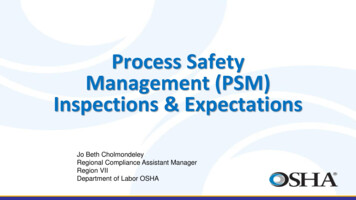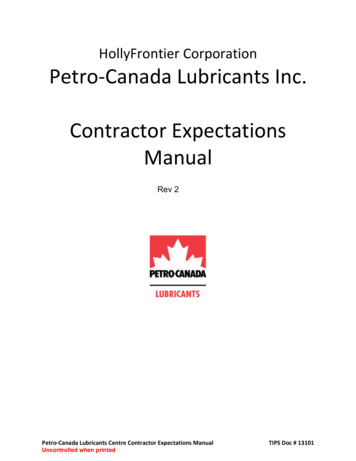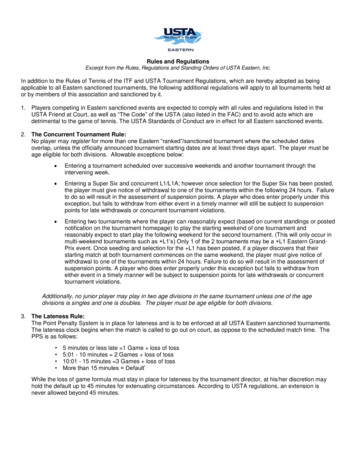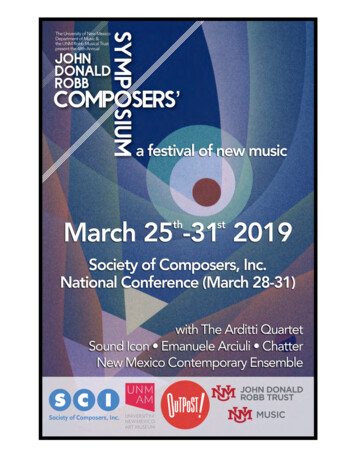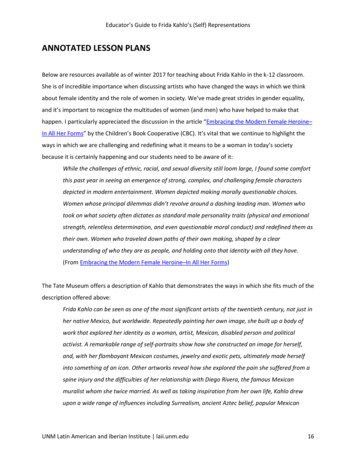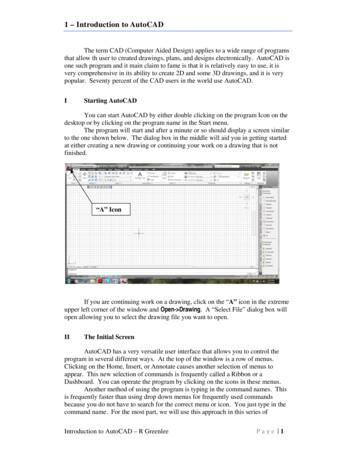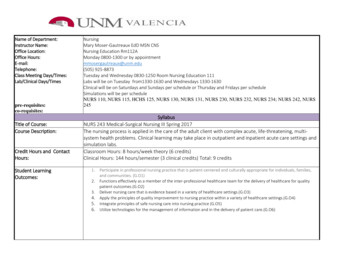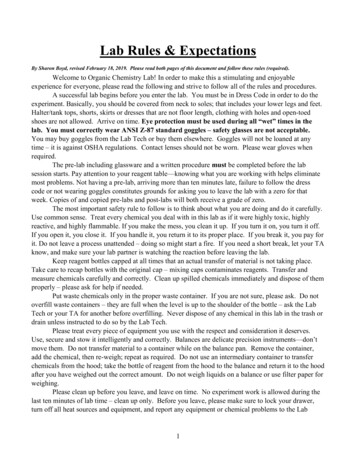
Transcription
Lab Rules & ExpectationsBy Sharon Boyd, revised February 18, 2019. Please read both pages of this document and follow these rules (required).Welcome to Organic Chemistry Lab! In order to make this a stimulating and enjoyableexperience for everyone, please read the following and strive to follow all of the rules and procedures.A successful lab begins before you enter the lab. You must be in Dress Code in order to do theexperiment. Basically, you should be covered from neck to soles; that includes your lower legs and feet.Halter/tank tops, shorts, skirts or dresses that are not floor length, clothing with holes and open-toedshoes are not allowed. Arrive on time. Eye protection must be used during all “wet” times in thelab. You must correctly wear ANSI Z-87 standard goggles – safety glasses are not acceptable.You may buy goggles from the Lab Tech or buy them elsewhere. Goggles will not be loaned at anytime – it is against OSHA regulations. Contact lenses should not be worn. Please wear gloves whenrequired.The pre-lab including glassware and a written procedure must be completed before the labsession starts. Pay attention to your reagent table—knowing what you are working with helps eliminatemost problems. Not having a pre-lab, arriving more than ten minutes late, failure to follow the dresscode or not wearing goggles constitutes grounds for asking you to leave the lab with a zero for thatweek. Copies of and copied pre-labs and post-labs will both receive a grade of zero.The most important safety rule to follow is to think about what you are doing and do it carefully.Use common sense. Treat every chemical you deal with in this lab as if it were highly toxic, highlyreactive, and highly flammable. If you make the mess, you clean it up. If you turn it on, you turn it off.If you open it, you close it. If you handle it, you return it to its proper place. If you break it, you pay forit. Do not leave a process unattended – doing so might start a fire. If you need a short break, let your TAknow, and make sure your lab partner is watching the reaction before leaving the lab.Keep reagent bottles capped at all times that an actual transfer of material is not taking place.Take care to recap bottles with the original cap – mixing caps contaminates reagents. Transfer andmeasure chemicals carefully and correctly. Clean up spilled chemicals immediately and dispose of themproperly – please ask for help if needed.Put waste chemicals only in the proper waste container. If you are not sure, please ask. Do notoverfill waste containers – they are full when the level is up to the shoulder of the bottle – ask the LabTech or your TA for another before overfilling. Never dispose of any chemical in this lab in the trash ordrain unless instructed to do so by the Lab Tech.Please treat every piece of equipment you use with the respect and consideration it deserves.Use, secure and stow it intelligently and correctly. Balances are delicate precision instruments—don’tmove them. Do not transfer material to a container while on the balance pan. Remove the container,add the chemical, then re-weigh; repeat as required. Do not use an intermediary container to transferchemicals from the hood; take the bottle of reagent from the hood to the balance and return it to the hoodafter you have weighed out the correct amount. Do not weigh liquids on a balance or use filter paper forweighing.Please clean up before you leave, and leave on time. No experiment work is allowed during thelast ten minutes of lab time – clean up only. Before you leave, please make sure to lock your drawer,turn off all heat sources and equipment, and report any equipment or chemical problems to the Lab1
Tech. Do not put “common use” equipment in your drawer – doing so will result in loss of benchpoints. Please clear and clean the balances, bench tops, hot plates, melt-temps, hoods, sinks, and allareas where you have worked.Absolutely no cell phone or audio device use is allowed in the lab at any time – turn them offbefore you come into lab and leave them off until you leave. Failure to do so will result in a grade ofzero for that lab. You may not leave the lab to make or take a call without your TA’s permission.Report any and all accidents and injuries to the Lab Tech. If either one of us believe that youneed medical attention you will get it. If an ambulance is called, it is at your expense. Please report anyand all spills to your TA immediately. Ask the Lab Tech for assistance as required. Do not take this labcourse at this time if you are pregnant or nursing.Failure to remember your drawer combination will result in a fifty cent fee. Locking yourdrawer is your responsibility – drawers will not be checked by the Lab Tech and you are responsible formissing items. All personal property brought into the lab and all Department equipment that you use areyour sole responsibility.If you check in to a drawer, you must check out of it. Failure to check out of your drawer withyour section as scheduled will result in fines and fees billed to you through the Bursar’s Office. The latefee for failing to check out with your section as scheduled is 50.00, applicable if you fail to appear forcheck out later than 30 minutes after your section is scheduled to start. Early check outs will only bepermitted through the fourth week of the semester (second week of summer session) or at the LabTech’s convenience. After that, you must show up for regular check out to avoid being billed. You maycontact the Lab Tech to schedule an appointment for check out, or for any other reason, at 277-6022 orvia email: seboyd@unm.edu. If you leave a voice message, speak slowly and enunciate. Repeat yourname and phone number so that your call can be returned. Only one call back attempt per call will bemade.There are no make up labs and you may not attend a section other than your own.You are expected to follow these rules and any and all instructions and rules given you byyour TA or the Lab Tech at all times or to leave the lab with a grade of zero for that week.In consideration for taking this course and using Chemistry Department equipmentyou agree to all of the above upon check-in.2
Course Policies, Grading, and ExamplesforChemistry 303L2020-20213
Organic Chemistry Lab – 303L SectionT.A.: , @unm.eduOffice Hours: Location:Chemistry 303LLaboratory Coordinator: Dr. Lisa J. Whalen (lwhalen@unm.edu), 277-0268, SMLC 289APrerequisites: Chem 1225, Chem 1225LCorequisite or Prerequisite: Chem 301Text: Laboratory Manual for Chemistry 303LLab Technicians: Sharon Boyd (seboyd@unm.edu), 277-6022, SMLC 190BRussell Milazzo (rmilazzo@unm.edu), 277-0837, SMLC 290BCourse Policies1. You must attend the section in which you are enrolled for the semester. You may not attendany other sections. It will result in a zero for the experiment.2. You cannot take Chem 303L and Chem 304L in the same semester. If you are pregnant ornursing, you are advised not to take organic chemistry lab this semester. See Dr. Whalen for moreinformation.3. There are no make-up labs for missed experiments – see page 8 for more information.4. You need a complete prelab report and must follow the dress code in order to perform anexperiment. Failure to comply with either will result in immediate removal from the lab and a grade ofzero for the experiment.5. In order to receive a grade for an experiment you must turn in a complete prelab report,perform the experiment, and turn in the postlab report. You will receive a grade of zero for missing anyof the above. If you sit in the hall outside the lab before the lab and you are caught copying lab reportsby Sharon Boyd, your TA, or Dr. Whalen you will not be allowed in the lab and will get a zero for thatlab. Completing a postlab report by copying data from another student when you yourself did not do thelab is called “drylabbing” and it is a prosecutable offense in industry. Students caught drylabbing willearn zeroes for the personal points and postlab report which cannot be dropped. Further offenses willresult in being dropped from Chemistry 303L or 304L.6. You must be on time for each experiment. If you are more than 10 minutes late it will beconsidered a missed lab and will result in a grade of zero.7. Stop your experiment early enough to clean up. Leaving the lab on time is required.8. It is not required to take Chem 301 and Chem 303L simultaneously. Completing Chem 301before Chem 303L is usually recommended for most students.9. There are supply fees required for this lab. They are not refundable. Unused amounts onyour breakage card are refundable.10. Quizzes are closed book, closed notes, and closed lab manual. If you are caught workingin a group, working with your lab notebook open, or otherwise using another aid while taking a quiz,you will receive a zero for that quiz. Further violations of this rule will result in dismissal from thecourse.4
Safety and Personal Welfare1. Goggles must be worn at all times when in the lab.2. If you get chemicals in your eyes, have somebody get Sharon Boyd or your TA andimmediately rinse your eyes for at least ten minutes using the eyewash station.-Long hair must be tied back.-If you wear loose fitting clothes, be very careful to not let them hit a hot plate or dip intochemicals.-Sandals, open toed shoes, shorts and skirts are prohibited.If they are worn you will be allowed to change your clothes as long as you are able to be back inthe lab within 10 minutes. If this is not possible, you will not be allowed into the lab and will receive azero for that lab.-No food, drink, or gum is allowed in the lab.-Cell phone use and text messaging is prohibited during the lab.3. If Sharon Boyd or Dr. Whalen feels that for any reason you are performing an unsafe task youwill be dismissed from the lab and receive a zero for the lab. This includes coming to lab under theinfluence of drugs or alcohol.Lab Procedures1. Prelab and postlab reports must be turned in at the beginning of the lab. If the prelab is notcompletely done when you arrive for lab, you will not be admitted to the lab and will receive a zero forthe lab. The procedure and glassware section must also be completed in your lab notebook before labstarts. It is handed in as part of the postlab report, usually the following week. See the schedule.2. Labs cannot start until you are told you can begin. You will work with one other personunless otherwise instructed.3. Do not leave a reaction unattended or do any unauthorized chemistry or you will be dismissedand receive a zero for the lab.4. Show your TA ALL products before you put them in the waste bottle.5. Do NOT pour any chemicals down the drain.6. Make sure all chemical bottles and containers are kept covered and away from any water.Using Your Lab Notebook1. Prelabs and postlabs must be ORIGINALS turned in on LAB NOTEBOOK PAPER or youwill not receive any credit. Ordinary notebook paper will not be accepted. A lab notebook has to havethe following features: 1) a solid or spiral bound notebook; 2) carbonless duplicated pages; and 3)numbered pages. Do NOT tear pages out of your lab manual; they will not be accepted.2. All entries must be made in INK. DO NOT USE PENCIL.3. Deletion of mistakes is to be made by drawing a line through the mistake, leaving the deletedmaterial legible. No pages are to be removed. A page may be deleted by crossing out the entire pagewith an X.4. All data is to be entered into the notebook as it is taken during the experiment. Copying datafrom loose pieces of paper is not acceptable and increases possibilities of errors. Your TA will look atyour observations/data to confirm that they are fully completed before signing your notebook.5
Grading PolicyQuizzes (20%):There will be quizzes with questions taken from concepts discussed in the lab manual and thelowest quiz score will be dropped.Prelab Reports (30% ): EXAMPLES ARE DESCRIBED ON PAGE 10.It includes preparation and write-up for each experiment and answers to prelab questions. Ifyou know you will be absent, turn in your prelab report early to receive full credit. See page 8.Postlab Reports (40%) : EXAMPLES ARE DESCRIBED ON PAGE 10.It includes detailed procedure, observations, and data for each step, results, calculations,conclusions and answers to postlab questions. The lowest postlab score will be dropped.Personal Evaluation (10%):Ten points per day will be given by your TA. Your TA will be watching for major experimentalerrors, whether you ask questions that your TA answered at the beginning of the lab, if you are not surewhat you are doing, or if you leave your area a mess. These will count as deductions from your score.If the lab is not cleaned up at the end of your section, everyone will lose points. If your sectiongenerates 2-3 times as much waste as normal, everyone will lose points. If community equipment isbroken and no one is told about it, everyone in the section will lose points.The lowest personal evaluation score will be dropped.The grading percentages are as follows:100-90% A; 89-80% B; 79-70% C; 69-0% DPlusses and minuses are assigned by Dr. Whalen at the end of the semester. Do not email to askwhere the cutoffs will be.Your TA cannot answer any grading questions during the lab. Please see him or her duringoffice hours in a confidential setting if you wish to discuss your grade.Prelabs – An example can be found on page 10.Name, Title of Experiment, Section # and Date (1 pt) – in the top margin of the page, ONEVERY PAGEReferences (1 pt) – Which sources did you use to get the information (theory, procedure andproperties of reagents) you need for this experiment? Most of the information will come from the labmanual and Sigma-Aldrich/MSDS/CRC Handbook.Purpose (3 pts) –MORE THAN ONE SENTENCE. Why are you doing this experiment? Whattechniques will you be using to make product from the reactants, (e.g., fermentation, distillation, reflux,etc) extract product from material, (e.g., steam distillation) isolate, (e.g., dissolution or filtration),separate the product from reaction mixture (gravity filtration, vacuum filtration, solvent extraction, etc),purify or dry the product (e., fractional distillation, vacuum, drying agent) and determine the purity oridentity of product (mp, TLC, GC, MS, UV, IR, etc)?6
Reaction (2 pts) – What is happening in this experiment? Use structures, not words, to write thereaction. Show only the net reaction that leads to the isolated product. Do not show side reactions thatlead to side products unless they are critical to the experiment.Mechanism (4 pts) – How does the reaction happen step-by-step? Draw arrows to showelectron flow from electron rich species or atoms in a molecule to electron poor species or atoms in amolecule. MECHANISMS NEED ALL ARROWS.Table of Reagents and Products (4 pts) – What chemicals are you using? What products areexpected? Give their MW, Mp, Bp, Fp, hazards, densities, and the amounts you will be using in the lab.You have to read the Lab Manual under reaction and properties and experimental procedure to get thenames of the products and all reagents and their amounts respectively. You have to refer to SigmaAldrich, CRC, or MSDS to obtain additional information needed to fill the table. You may put dashes orN/A for missing information.Calculations (3 pts) – How much of what are you using, and what is your theoretical yield?SHOW ALL CALCULATIONS. Which of the reactants is a limiting reagent? What is your theoreticalyield (in grams) of the product? SHOW ALL CALCULATIONS.Prelab Questions (variable) – They are in the lab manual. They need to be completed becausethey are a large portion of your prelab grade. The answers for most of these questions are in the lab manual.Everything to this point must be handed in at the beginning of the lab period.Procedure and glassware descriptions are part of the postlab but must be completed before youcan begin the experiment.Postlabs – An example can be found on page 10.Name, Title of Experiment, Section # and Date (1 pt) – in the top margin of the page, ONEVERY PAGEProcedure / Glassware and Observations/Data (6 pts) –1. Make a clearly labeled drawing(s) of the glassware set-up(s) to be used in the experiment. You have tocopy the drawings given in the lab manual.2. Divide the page into two halves and write a condensed version of the experimental procedurestepwise on the left side of the page. THESE MUST BE DONE BEFORE YOU COME IN for the experimentand should be left intact in your lab notebook. Your TA will check for this and if you do not have it done youWILL NOT BE ALLOWED to proceed with the experiment.3. The right side of the page is reserved for systematic recording of observations (color changes, odor,precipitate formation, cloudiness, filtrate, dissolution, etc) and data (mass, volume, temperature changes,melting points, hot plate settings, etc). YOU WILL RECORD OBSERVATIONS or DATA or both for eachstep during the experiment. Record any spills or samples left during filtration or transfers from one apparatus toanother or if solid recovered is wet or dry. These may cause a lower or higher mass of the final product thanexpected. If the product is wet or not dry enough it may decrease the purity of the product.Results (4 pts) – What was the mass of your final product? Melting point? Percent yield? ShowALL calculations that gave you these numbers. What is the purity of the product based on melting point or GC,TLC, etc?Conclusion (4 pts) – Discuss and interpret your results in a paragraph. State whether yourexperiment was successful. You have to explain how much of the product you did obtain (give the mass) andwhat was the theoretical yield (give the mass) of the product. State if the experimental mass of the product ishigher or lower than the theoretical mass. Give the plausible reasons if your product yield is lower than expected7
(e.g., sample loss, incomplete reaction, insufficient extraction, etc) or higher than expected (contamination frommaterial during filtration or extraction or drying agent, wet product due to water or solvent, etc). How pure wasyour product based on melting points or TLC, GC, UV, etc? What plausible causes of higher or lower thanexpected Mp? What problems did you have with the experiment and what would you do differently next time?Postlab Questions (variable) – In the lab manual. They need to be completed because they are alarge part of your postlab grade. Show the numerical values when you make comparisons between sampleand standard values or experimental values and theoretical values. If the question requires you to perform thesame calculations done in the results section, YOU MUST REPORT the values but you may write “refer toresult section for detailed calculations.” YES or NO answers without explanation are not acceptable.Missed Lab PolicyStudents are not permitted to attend other lab sections because this can result in a violation of fire codefor SMLC 190/290. Because there are no free times during the semester to hold make-up labs, you areencouraged to turn in all assignments ahead of time that are due during the week you will miss a lab.You can slide STAPLED AND COMPLETELY IDENTIFIED ASSIGNMENTS under Dr. Whalen’sdoor, SMLC 289A, before Friday of the week you are absent. If the assignments are not stapled or Dr.Whalen cannot determine which TA should receive the assignments, you will receive a zero. Since thelowest postlab, quiz, and personal points scores are dropped before your final grade is calculated, oneabsence will not hurt your overall grade.8
Some common pieces of glassware in your drawer:9
10
11
12
13
14
15
16
17
18
19
20
Prerequisites: Chem 1225, Chem 1225L . Corequisite or Prerequisite: Chem 301 . Text: Laboratory Manual for Chemistry 303L . Lab Technicians: Sharon Boyd (seboyd@unm.edu), 277-6022, SMLC 190B Russell Milazzo (rmilazzo@unm.edu), 277-0837, SMLC 290B . Course Policies . 1. You must attend t
